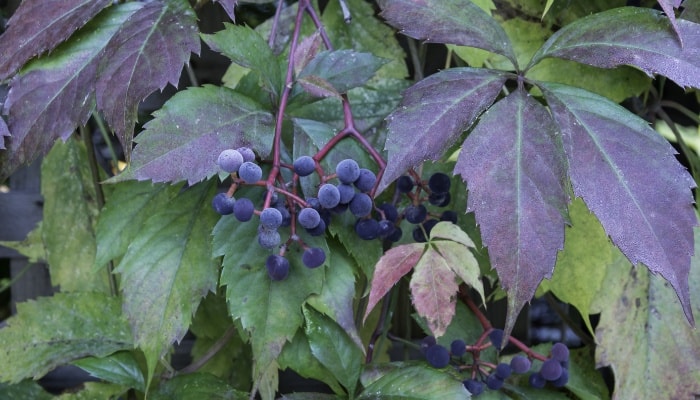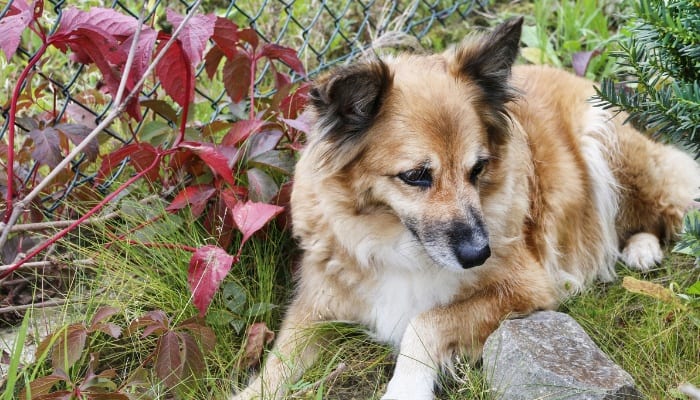As Virginia creeper (Parthenocissus quinquefolia) spreads across your fence or the forest ground, you may question whether it poses a danger to your dogs.
While it may not be the first thing your dog goes for in the yard, it can be an issue to their health. Both the berries and leaves contain substances that will cause health issues easily identified with certain symptoms.
Is Virginia creeper poisonous to dogs? Virginia Creeper contains oxalic acid, which is considered a moderate toxin to dogs and can be fatal if consumed in high quantities. It is found in the leaves, but the highest concentrations are found in its berries, which mature in the late summer and fall.
Looking out for your pets is always a priority, and when Virginia creeper is a large part of your landscape, it can be concerning.
Read on to understand how poisonous the vine is, what to do if your dog eats any part of it, and some safer alternatives to plant to ensure your dog will never eat a poisonous plant in your landscape!
Dogs and Virginia Creeper – What To Know
Dogs normally don’t eat plants as a large part of their diet, but they do get curious at times!
The leaves of the Virginia creeper vine contain poisonous oxalate crystals and may cause irritation if they are eaten or if skin comes into contact with the sap.
The berries are where the oxalic acid is found in the highest concentrations and is the part of the plant to keep your dogs away from.
Virginia Creeper Toxicity
Most animals can not digest oxalate crystals, the form in which oxalic acid is found within the plant, and it will cause gastrointestinal pain or irritation if consumed.
It is considered moderately toxic to dogs and mammals, so if they eat one or two, it shouldn’t be an issue.
However, sometimes dogs consume the leaves and the berries, eating them in large enough quantities that will cause greater health issues.
Is Virginia Creeper Poisonous To Touch?
Virginia creeper is not poisonous to touch, but the needle-like oxalic crystals called raphides in the leaf tissue can cause irritation.
It will also cause irritation to the skin if you come in contact with the sap. Always wear gloves when working with this plant to reduce the chances of any skin contact.
Virginia Creeper Berries
The berries are the most poisonous part of the plant and contain high amounts of oxalate crystals. Oxalic acid is known to be a moderately toxic chemical if ingested in a high enough quantity.
The insoluble oxalate crystals are the most harmful once the berries have matured, so be sure to keep an eye on your pets during the late summer and fall when the berries turn red and purple.
Will Dogs Eat Virginia Creeper?
Dogs are usually willing to try anything once, so while it isn’t a favorite all dogs seem to enjoy, they may eat it at some point.
Hopefully, they will only nibble the leaves, but in some cases, they consume them along with the berries by accident or simply find and sample them once they’ve dropped on the ground.
Symptoms of Virginia Creeper Poisoning
Even if you didn’t see your dog eat any part of the vine, he or she may have eaten berries no longer directly on the plant.
If you notice any of the symptoms below and suspect it could be due to having eaten Virginia creeper berries, be sure to take your dog to the vet immediately.
Oxalic Acid Poisoning Symptoms in Dogs
- Cardiac arrhythmia
- Difficulty swallowing and breathing
- Dilated eyes
- Excessive drooling
- Loss of appetite
- Unusual barking
- Diarrhea
What To Do if You Suspect Your Dog Ate Virginia Creeper
It is always best to leave any diagnosis to a professional, so if you suspect your dog has eaten Virginia creeper, take them to the vet immediately.
Even minor symptoms may cause issues that are long lasting or extremely uncomfortable for your pet to live with.

Virginia Creeper Effects on People
The toxicity of Virginia creeper is something that the majority of mammals will be affected by. While it mostly depends on the size and age of the person, some symptoms will still present themselves.
While most people won’t die from eating a few berries, when eaten in large quantities, people will feel effects that should be monitored or treated immediately.
See the most common symptoms of oxalic poisoning in people listed below.
Oxalic Acid Poisoning Symptoms in People
- Abdominal pain
- Burns and skin irritation where the acid was ingested in the mouth or throat.
- Nausea
- Vomiting
- Diarrhea
Poisonous Vines – Keep Your Dog Away From These
Other commonly grown poisonous vines that can cause issues for dogs are listed below. Click here for the ASPCA’s full list of plants that are toxic to dogs.
- Clematis varieties (Clematis pitcheri, C. dummondii, etc.) – All parts are poisonous, but luckily it has a bitter taste most dogs dislike.
- Ivy (Hedera sp.) – All parts are mildly toxic.
- Morning glory (Ipomoea sp.) – Has seed pods that may cause hallucinations.
- Wisteria (Wisteria frutescens) – Has toxic seeds and pods.
Climbing Plants Safe For Dogs
It’s better to be safe than sorry, so when possible, always try to plant climbing plants that don’t have poisonous qualities.
See the list below for varieties of climbing plants that are not toxic to your pets.
- Passion fruit (Passiflora affins, P. incarnata)
- Coral Honeysuckle (Lonicera sempervirens)
- Jasmine (Jasminum sp.)
- Climbing roses (Rosa sp.)
- Crossvine (Bignonia capreolata)
Related Questions:
Is Virginia Creeper Poisonous to Cats?
Just as it can cause discomfort and gastrointestinal issues in dogs, Virginia creeper is also toxic to cats. They find the berries tasty and intriguing, playing with them at times.
Be sure to watch your cat when near Virginia creeper vines, especially if he or she seems to be behaving unusually. Cats will experience many of the same symptoms that dogs and humans experience.
Does Virginia Creeper Damage Walls?
Virginia creeper uses aerial roots called “holdfasts” to attach itself to trees and other surfaces. It will damage walls that are painted, stucco-finished, or made of other soft materials.
It is commonly grown on masonry and stone walls that are able to withstand the roots’ gripping abilities.
Closing Thoughts
It is always a good idea to keep your pets away from Virginia creeper! If they do happen to eat the berries, it can be cause for concern, and you should act quickly.
Planting other varieties with no poisonous attributes is probably a better bet when possible, but Virginia creeper is a native plant that is commonly found in forests and landscapes, so always keep an eye out for it!

